by Diane Coles Levine, Janice Cimbalo, and Rodney Stone — In the television show “Leverage,” a team of five modern day Robin Hoods use their skills to fight corporate injustice, help ordinary people gain power over inequality and recover their losses. As a friend described this show to us, we immediately thought about how companies embarking on their relocation projects could use this team to help them gain leverage.
Why? Because too much leverage is lost in organizations due to a lack of a comprehensive real estate and workplace strategy. Corporate relocation and restack projects often run over budget because of poor decisions, insufficient data, inexperienced teams, and the absence of a clear vision or strategy. To illustrate this point, several “not-so-good” workplace project case studies are highlighted throughout this article. In contrast, this article concludes with an example of an “award-winning” case study that achieved $38 million in leverage.
Although real estate / FM is one of the largest line items in a corporate budget, executive decisions about the workplace can have an adverse effect on these budgets. This article discusses how FMs can drive executive understanding about the benefits of using leverage and aligning business and workplace strategy to deliver quantifiable results.
Leverage is a strategic or tactical advantage, and, as a verb, means to exploit such an advantage. It’s similar to using a physical lever that gives you a physical advantage. For example, you can more easily lift a heavy object using a lever as a tool than you can lift it unaided. Given this, what tools can FMs use to leverage their workplace projects? How can FMs support and influence executives in making sound workplace decisions that drive business outcomes?
We identified five areas in which FMs can gain or lose leverage in a relocation or restack project as shown in Figure 1: Five areas to gain leverage in a workplace project.
They are:
1. Team – Create a winning team with the right players
2. Timing – Bring the key players in at the start of the project
3. Data – Use data to make informed decisions
4. Costs – Develop accurate budgets and financial projections
5. Negotiations – Devise a clear negotiations strategy
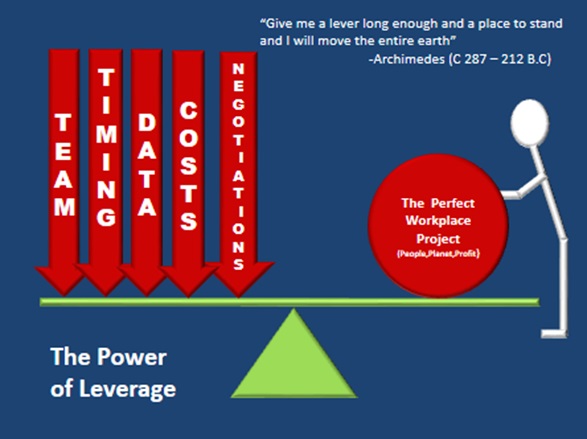
Gaining Leverage – Team and Timing
In a workplace transformation, it is important to bring the key players to the table at the beginning including the real estate broker, workplace strategist, architect, general contractor, change manager, client representative and furniture vendor to gain the greatest leverage, Figure 2: Gaining leverage with team and timing.
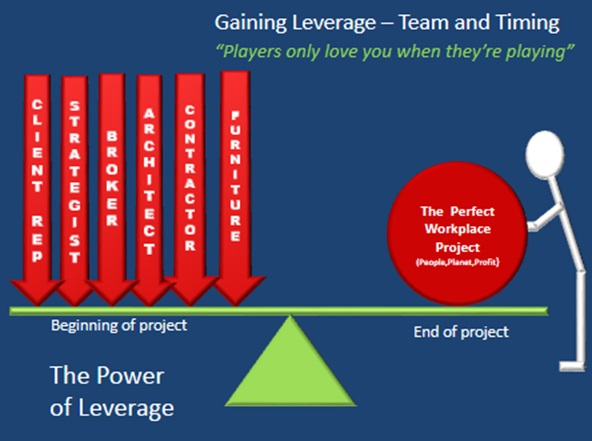
A “Not-So-Good” Case Study Resulting in Lost Leverage
A company in California recently lost approximately $1.9 million in a relocation project because they neglected to hire a workplace strategist and waited to engage an architect and construction project manager until after lease execution. Therefore, instead of being able to know their programming and real estate requirements with certainty, they had to work with what they had just acquired. In addition, without an architect from project inception, the company did not perform a facility condition assessment of their new building prior to signing the lease (Figure 3: Losing leverage with team and timing). Once hired, the architect and construction project manager found major structural issues with the roof along with other building engineering problems causing additional unforeseen construction costs, major delays, change orders and additional expenses in holdover rent. Also, there was no alignment between business strategy, people and technology. The new building was too small to meet future workforce and technology requirements, causing the agency to lease more space nearby at year two of their new five-year lease.
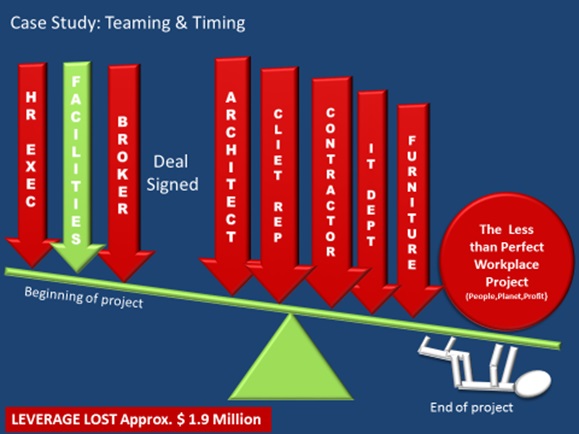
Finally, there wasn’t enough time allocated to build the new office in the nine months the agency apportioned before their existing lease expired. The project finished seven months behind schedule causing additional A&E and construction costs. Had this organization created a winning team early in the project, they would have gained rather than lost leverage.
Gaining Leverage with Data
To determine the location strategy and size of an office, you need to understand the business strategy, expansion plans, workforce projections and technology plan. Taking a holistic approach results in better negotiations and better space. Making data driven decisions helps gain leverage, save costs and ultimately attract and retain talent.
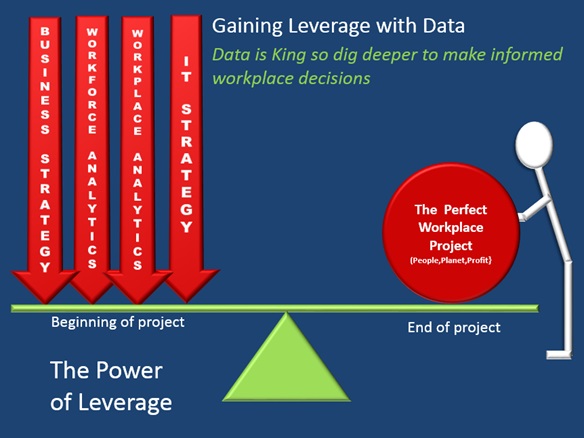
Finding the right space requires research to develop a workplace strategy backed up by analytics to ensure costs and project timelines are manageable. Figure 5: Workplace + Workforce Intelligence shows the different data needed to size, select, design and construct the right facility to enhance the employee experience. To do this, you need to know how many people and what technology is necessary to support those people. Designing and constructing a workplace that meets business objectives requires careful examination of the current and future building options including operating costs, facility condition, capital costs, space utilization, smart technology and more. To enhance the work experience, data on employee amenities such as satisfaction surveys, costs, and usage are valuable when planning for future services like a cafeteria and fitness center.
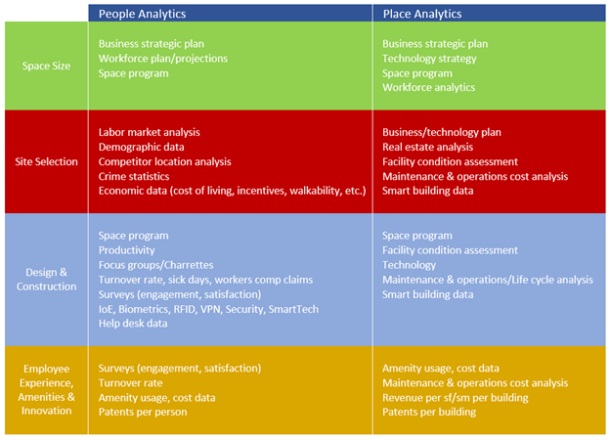
A “Not-so-Good” Case Study in Lost Leverage, continued
In our case study, the company used two year staffing projections to size their new office. They did not calculate workforce projections beyond two years. As a result, they ran out of space at the end of the first year of their new lease. Key building system components required in the Information Technology strategic plan were not included in the plans. After construction started, the team realized that one department was missing from the original space plan. These issues caused the project manager to re-negotiate space between business units, who were subsequently forced to give up their precious meeting rooms. The fitness center and cafeteria were included in the plans after construction started resulting in more re-negotiation of space, more delays and more funding as shown in Figure 6: Data and Leverage Lost. Had this organization dug a little deeper into their workforce and workplace analytics, these issues could have been found earlier in the process.
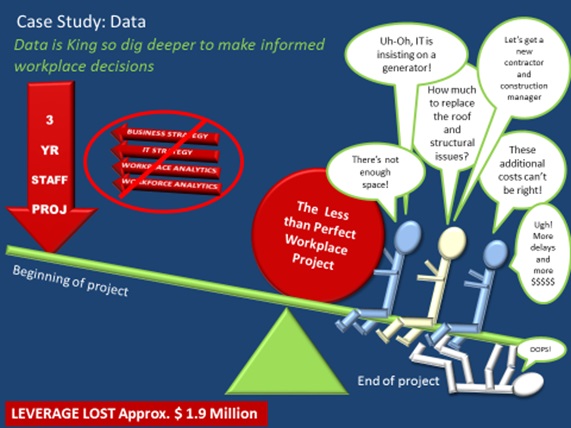
Gaining Leverage — Cost and Negotiations
A well thought out negotiations strategy is a critical piece in gaining leverage. Understanding the workplace strategy and facility condition of current and potential buildings puts the tenant in a better position to negotiate landlord concessions, base building and tenant improvements. An early understanding of the employee amenities, services and technology requirements allows for better planning up front when creating the real estate negotiations strategy and project budgets. The entire project team should have input into the budget.
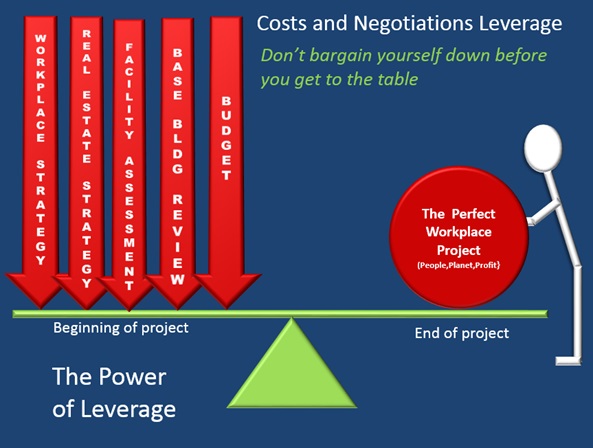
A “Not-So-Good” Case Study in Lost Leverage, continued
The budget created for the company in our case study was not reviewed by all members of the project team. The architect, project manager and general contractor were consulted after the lease was signed and the budget approved. As a result, unforeseen conditions including a faulty roof and structural issues were discovered too late causing the executive team to go back to the board to request additional funds, Figure 8: Losing leverage with costs and negotiations.
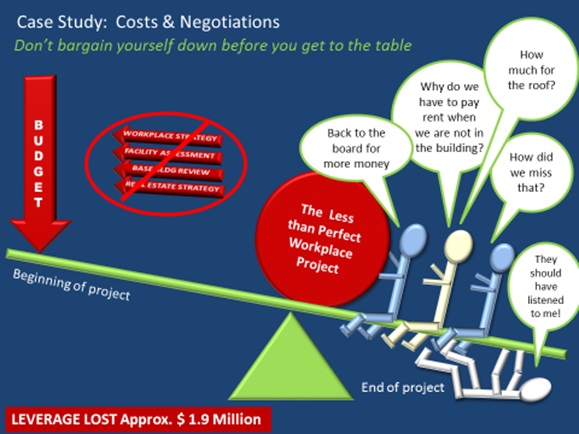
Gaining Leverage, an “Award Winning” Case Study in Success
A health insurance company in California recently renegotiated their lease for a 12-year term gaining approximately $38 million in leverage. The drivers for workplace change were cost containment, high growth and employee attraction and retention. How did they do it?
Team
The external broker, architect, workplace strategist, contractor, project manager, furniture vendor, and internal human resources, IT, real estate, finance and FM departments were all present at the beginning of the project for this $120 million lease renewal
Results: They were able to negotiate base building improvements, high tenant improvement allowance, free-rent, fiber optics, and campus technology improvements. The workplace strategy allowed for better real estate negotiations.
Timing
The project started 3.5 years before lease expiration giving plenty of time for a lease or purchase decision.
Results: This company capitalized on market conditions and they had plenty of time for strategic planning and negotiations. The real estate and workplace strategy allowed for options beyond the existing area. The telecommuting program caused over-standard parking issues with the landlord and, if needed, time was available to construct a parking facility.
Data
Workforce planning, workplace analytics and technology plans were used to understand requirements. The facility and IT building and infrastructure data were key to negotiations.
Results: Data allowed for better negotiations. Facility and security data were instrumental in negotiating unprecedented base building and higher tenant improvement allowance along with parking cost concessions.
Costs
The entire project team had input into the budget
Results: An accurate budget was created with no project overruns.
Negotiations
The team had a well thought-out negotiations strategy developed with input from internal departments and external vendors.
Results: Saved approximately $38 million
Conclusion
The opportunity for leverage is in your office move or restack project. This is a fitting time to align people, place, process and technology with the business strategy. Making informed business decisions using workplace and workforce analytics not only increases leverage it also improves quality of life for employees. As FMs, perhaps we should consider behaving more like the modern day Robin Hoods in the TV show “Leverage” and arm the C-Suite with information they need to drive business results in the workplace.
Diane Coles Levine is the Executive Director of the IFMA Foundation. Previously, she was the founder and managing partner at Workplace Management Solutions. She served on the IFMA Board of Directors, is Past Chair of the IFMA Foundation and was named the 2015 IFMA Corporate Real Estate Council Distinguished Member. She is an international speaker and guest lecturer at Vienna University of Technology and MIT Professional Education Programs. Diane is co-editor and author of Work on the Move.
Janice Cimbalo, Esq., MCR, is Senior Vice President of JLL focused on a proactive workplace strategy within the real estate process and is currently serving on the Board of IFMA’s Corporate Real Estate Council and is involved with CoreNet She co-authored two publications: Cut it Out, and Work on the Move.
Rodney Stone is the President of Environetics. Educated at Pratt Institute School of Architecture, Rodney is a frequent lecturer on workplace strategy and design, FM technology, and FM tools. Rodney is the past president of IFMA’s Computer Applications Council and an active member of CoreNet.